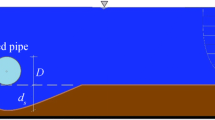Abstract
The estimation of scour depths is extremely important in designing the foundation of piers which ensure the integrity of bridges and other hydraulic structures. Complicated hydrodynamic processes around piers are the main challenge to formulate explicitly empirical equations in providing scour depth estimation. Consequently, the proposed empirical formulae only yield good prediction results for specific conditions. In this study, the particle swarm optimization and Firefly algorithms are proposed to optimize artificial neural network (ANN) models to improve predicting the scour depths around circular piers at the equilibrium stage. The results of the proposed modelling frameworks are compared with an ANN network trained by the Levenberg–Marquardt (LM) algorithm which was widely adopted in the literature for prediction purposes. The predicted results exhibit that the equilibrium maximum scouring depths derived from our proposed models are better compared to the values from empirical models and the single ANN model trained by LM. Our study implicates that the new model frameworks could successfully replace the traditional methods, and more applications of these frameworks on computational fluid mechanics and hydraulic structure designs should be considered.
Similar content being viewed by others
References
Bhattacharya B, Price RK, Solomatine DP (2007) Machine learning approach to modeling sediment transport. J Hydraul Eng 133(4):440–450
Breusers HNC, Nicollet G, Shen HW (1977) Local scour around cylindrical pier. J Hydr Res IAHR 15(3):211–252
Chabert J, Engeldinger P (1956) Etude des affouillements autor des piles de ponts. Lab. Natl. d’Hydraul, Chatou
Chiew YM (1984) Local Scour at Bridge Piers. Rep No 355. School of Engineering, The Univ. of Auckland, Auckland, New Zealand
Damanjeet Kaur UIET (2014) Factors influencing performance of firefly and particle swarm optimization algorithms. Int J Adv Res Comput Eng Technol (IJARCET) 3(10):3559–3563
Ettema R (1980) Scour at bridge piers. Report No 216. University of Auckland, Auckland, New Zealand
Ettema R, Melville BW, Barkdoll B (1998) Scale effect in pier-scour experiments. J Hydraul Eng 124(6):639–642
Graf WH (1995) Load scour around piers. Annual Report. Laboratoire de Recherches. Hydrauliques, Ecole Polytechnique Federale de Lausanne, Lausanne, Switzerland, pp B.33.1–B.33.8
Hancu S (1971) Sur le calcul des affouillements locaux dams la zone des piles des ponts. In: Proceedings of 14th IAHR Congress, Paris, France, vol 3, pp 299–313
Haykin S (1999) Neural networks. A comprehensive foundation, 2nd edn. Prentice Hall, Englewood Cliffs, p 696
Hoffmans GJ (2017) Scour manual. Routledge, Abingdon
Jain SC, Fischer EE (1980) Scour around bridge piers at high flow velocities. J Hydraul Eng ASCE 106(11):1827–1842
Jeng D-S, Bateni SM, Lockett E (2006) Neural network assessment for scour depth around bridge piers. Research report no. R855, Environmental fluids/wind group. Department of Civil Engineering, University of Sydney, NSW, Australia
Kaya A (2010) Artificial neural network study of observed pattern of scour depth around bridge piers. Comput Geotech 37(3):413–418
Kennedy J, Eberhart R (1995) Particle swarm optimization (PSO). In: Proceedings of IEEE international conference on neural networks, Perth, Australia, pp 1942–1948
Khassaf SI, Abdulwhab AQ (2016) Modeling of local scour depth around bridge piers using artificial neural network. Adv Nat Appl Sci 10(11):71–79
Kothyari UC, Grade RJ, Ranga Raju KG (1992) Temporal variation of scour around circular bridge piers. J Hydraul Eng ASCE 118(8):1091–1106
Laursen M, Toch A (1956) Scour around bridge piers and abutments. Bulletin no 4. Iowa Institute of Hydraulic Research, Iowa Highway Research Board, Ames, IA, US
Lee TL, Jeng DS, Zhang GH, Hong JH (2007) Neural network modeling for estimation of scour depth around bridge piers. J Hydrodyn 19(3):378–386
Legates DR, McCabe GJ Jr (1999) Evaluating the use of “goodness-of-fit” measures in hydrologic and hydroclimatic model validation. Water Resour Res 35(1):233–241
Łukasik S, Żak S (2009) Firefly algorithm for continuous constrained optimization tasks. In: Nguyen NT, Kowalczyk R, Chen SM (eds) Computational collective intelligence. Semantic web, social networks and multiagent systems. ICCCI 2009. Lecture notes in computer science, vol 5796. Springer, Berlin, Heidelberg
Melville BW (1997) Pier and abutment scour: integrated approach. J Hydraul Eng ASCE 123(2):125–136
Melville B, Chiew YM (1999) Time scale for local scour at bridge piers. J Hydraul Eng 125(1):59–65
Melville BW, Sutherland AJ (1988) Design method for local scour at bridge piers. J Hydraul Eng 114(10):1210–1226
Moré JJ (1978) The Levenberg–Marquardt algorithm, implementation and theory. In Watson GA (ed) Numerical analysis. Lecture notes in mathematics vol 630. Springer
Oliveto G, Hager WH (2002) Temporal evolution of clear-water pier and abutment scour. J Hydraul Eng 128(9):811–820
Penz P (2013) Contraction scour modelling using artificial neural networks. MSc. thesis. Munich Technische Universität, München, Germany
Richardson JE, Panchang VG (1998) Three-dimensional simulation of scour-inducing flow at bridge piers. J Hydraul Eng 124(5):530–540
Richardson EV, Davis SR (2001) Evaluating scour at bridges. Hydraulic Engineering Circular No 8, FHWA NHI, Washington, DC, USA
Salaheldin TM, Imran J, Chaudhry MH (2004) Numerical modeling of three-dimensional flow field around circular piers. J Hydraul Eng 130(2):91–100
Shahin MA, Jaksa MB, Maier HR (2008) State of the art of artificial neural networks in geotechnical engineering. Electron J Geotech Eng 8:1–26
Shen HW, Schneider VR (1969) Local scour around bridge piers. J Hydraul Div Proc Am Soc Civ Eng 95(HY6):1919–1940
Sheppard DM, Odeh M, Glasser T (2004) Large scale clear-water local pier scour experiments. J Hydraul Eng 130(10):957–963
Talukder S (2011) Mathematical modelling and applications of particle swarm optimization. PhD thesis. Blekinge Institute of Technology
Tran Anh D, Duc Dang T, Van Pham S (2019) Improved rainfall prediction using combined pre-processing methods and feed-forward neural networks. J 2(1):65–83
Yang XS (2008) Nature-inspired metaheuristic algorithms. Luniver Press, Beckington, pp 242–246
Yanmaz M, Altinbilek HD (1991) Study of time-dependent local scour around bridge piers. J Hydraul Eng 117(10):1247–1268
Author information
Authors and Affiliations
Corresponding author
Additional information
Publisher's Note
Springer Nature remains neutral with regard to jurisdictional claims in published maps and institutional affiliations.
Rights and permissions
About this article
Cite this article
Dang, N.M., Tran Anh, D. & Dang, T.D. ANN optimized by PSO and Firefly algorithms for predicting scour depths around bridge piers. Engineering with Computers 37, 293–303 (2021). https://doi.org/10.1007/s00366-019-00824-y
Received:
Accepted:
Published:
Issue Date:
DOI: https://doi.org/10.1007/s00366-019-00824-y









